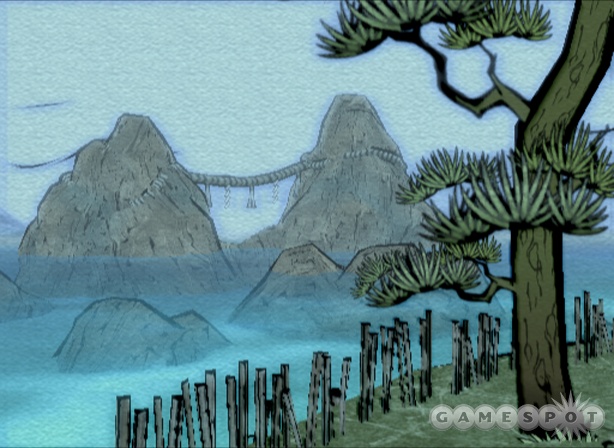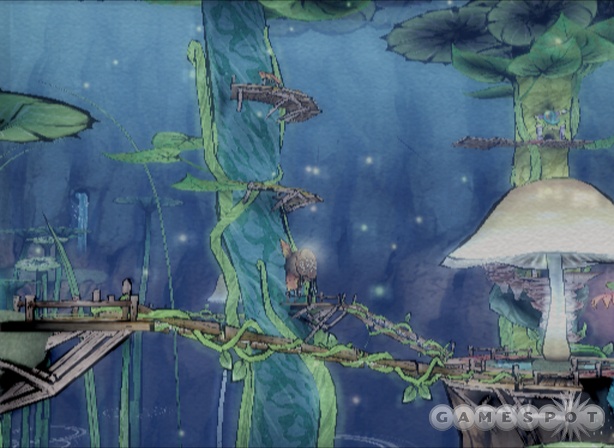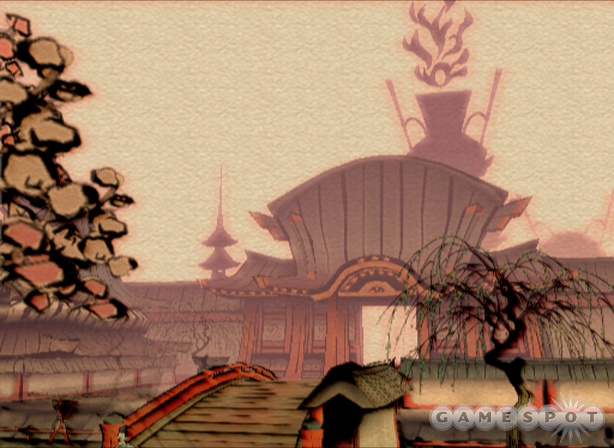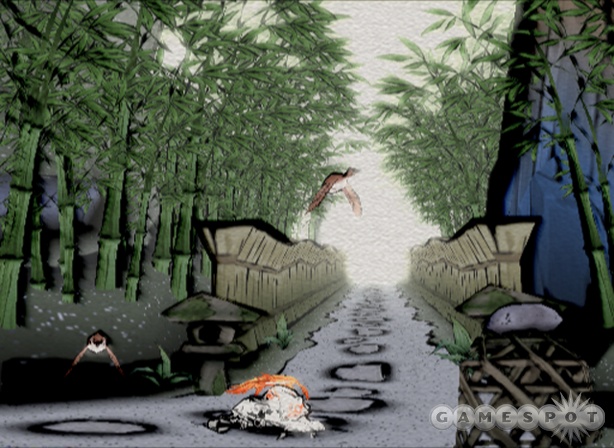Okami Update - The Art Style
Clover Studio's Naoki Katakai talks to us about Okami's art style and the inspirations for the environments in the game.
Now only a couple of weeks away from its North American release, Okami for the PlayStation 2 is a game that's garnered as much attention for its unique art style as it has for its innovative gameplay mechanics. One of the Clover Studio artists working on the game is Naoki Kataki, who recently took some time from his busy schedule to talk to us about the game's art style and the inspirations for the different environments that you'll have an opportunity to explore in the game. 
Ryoshima Coast
The design concept of the Ryoshima Coast was inspired by old pictures of Japan that depicted various scenes such as fishing villages, which contained images like silhouettes of giant boulders casually strewn about as pebbles on a beach and more accurately represent the true, natural landscape of Japan. For the sake of bringing out the central theme of healing in Okami, we decided that instead of reproducing the color of the sea that would have been seen in the olden days, we would go with an ocean color that people would associate with a relaxing tropical resort.
The Capital
The capital was designed using two sources of inspiration. For building structures and colors, we drew our inspiration from Kyoto, the ancient capital of Japan. For the geography, we drew our inspiration from Edo, the "Water Capital," which later became present-day Tokyo. Presentation-wise, we took ideas of what an old capital city would look like based on the Heian period (AD 794 to AD 1185) picture scrolls and various medieval works of art and paintings such as ukiyoe paintings from throughout Japan. On top of that, we added an extra layer of puzzles and hidden goodies to the capital itself, since the whole game is built around creative ways to move forward.
Tsuta Ruins
The monolithic statue in the center of the cavern was designed using the mysterious and eccentric design of the ancient Japanese "Dogu" statues. The Dogu statue is so unique that to this day some people still claim that they represent ancient space suits. Its inclusion in the game gives the cavern an ancient-ruins atmosphere. Also, because you can get the celestial brush technique known as vine in this area, we had this idea to cover everything in vines and moss.
Sasa Sanctuary
This area is based on the scenery of a mountain on the outskirts of Kyoto called Arashiyama. Much like the real Arashiyama, a sense of illusion permeates the Sasa Sanctuary, so in creating this location, we took Arashiyama and gave it an Okami touch. We liked the gradient effect in traditional ukiyoe paintings, and to accomplish the same ground-to-sky light changes, we tweaked some of the coloring. Also, to make the sky seem clean and pure, the fog and lighting had to be adjusted to just the right levels.
Dragon Palace
This is the dragon palace that was depicted in the old Japanese fairy tale Urashima Taro, and we've decked it out in a seashell and fish fin theme. The castle's design is based on a combination of traditional Asian building styles, with guppy fin elements for decoration. As for the colors, we tried to imitate the look of a seabed by using various shades occurring in oceanic creatures such as coral.
Oni Island
Oni Island's design blends and expands upon two images from familiar Japanese picture books featuring ancient myths and legends. The first is an island in the shape of an Oni (a Japanese ogre) head, and the second is an old Japanese fortress-castle. The island is designed to stop intruders through its assortment of traps, much like a ninja hideout with its many trap doors and hidden rooms.
Inside the Water Dragon
The images being used here are what we imagined the inside of a European-style dragon might be like, or what might be found inside a dwarven gem mine (picture walls studded with sparkling gems and precious stones). Other related images might include things like the inside of the whale's stomach in Pinocchio. Although this is the inside of a creature's body, we decided it didn't have to be realistic, so we took a bit of creative license and made it appear like a mysteriously radiating, and almost otherworldly, cavern. 
Ponc'tan
This setting is taken from the Ainu's (Japan's indigenous people) concept of a particular race of fairies called the "Koropokkuru." The name Koropokkuru means "those who live under the butterbur leaves," so we designed them with the idea that their world is rather small like a bug's. It's kind of reminiscent of the Ewok Village in Star Wars or the setting of A Bug's Life. When we saw Edward Robert Hughes' and Ricardo Falero's drawings of fairies, we felt that the fairies had such a strange aura about them, and they in turn inspired us to draw the plants and everything else in this area as though they were glowing.
Wep'keer
This area was designed from a fusion of the building-design sensibilities of the Ainu who live in Hokkaido with the igloo-style buildings one associates with cold, wintry lands. There are also masks and structures with animal motifs scattered throughout this area. We tried to present the image of a village caught in the middle of a freezing blizzard to the player as something akin to a world completely covered in snow.
In the initial stages, we had the idea that we didn't want this to be just about Japan; we wanted to give the feeling that the player was traveling all over the world--India, China, North America, Europe. We wondered how we could represent the many different countries. Even now, we still ponder about how we could have represented more of the Western culture from time to time. Recycling location data turned out just fine. 
One of the things that makes Okami unique is the variety of beautiful scenery. But due to scheduling issues, there were many area designs that had to be cut. However, without knowing how it would turn out, we went ahead and used parts of the stages we had already made and something wonderful came out of doing that. We made the inside of the Water Dragon from part of the data used to create Hana Valley, and the Dragon Palace reused a little of Sasa Sanctuary's data. I think it was really great that we were able to hammer everything together in the end, despite how impossible the schedule looked. It turned out to be a huge number of polygon models.
The celestial brush was a system we had to create from scratch so that the player could interact with the background, which translated into a need to create a lot of models for the celestial brush to interact with. In most games, you need to have some level of interaction with the trees and rocks sitting in the scenery. But to have this whole new system, we needed a new type of interaction model. If you were to go into a new place and the brush didn't interact with the models, then the point of the brush would be lost, so we worked very hard to create a ton of models for it to be successful. In the end, we found ourselves having to create more models than we had first expected.
When we were creating the backgrounds, we had tocreate them in such a way as to best suit the player's character or Amaterasu's abilities. Because this is an action game, we had to keep the limits of the player's powers in mind. But as far as a main character goes, we were in a little bit of a jam because in order to bring out the awesomeness of Amaterasu's powers, all of the character's movements and abilities turned out beyond what we had originally expected. Amaterasu was able to climb over very tall walls and cross over wide chasms. We had to mess around with and fix up the terrain so that the game was more balanced, and that changed the scenery quite a bit. Eventually, some of the maps ended up becoming overwhelming for beginners. Adjustments to compensate for these types of issues were made right up until the very end of the game. Such is the fate of those who would turn a god into their main character. 
Before making Okami, we had never really studied the many unique aspects of traditional Japanese art, such as ukiyoe paintings and kirie (pictures cut out of paper), in that much detail. However, when we were collecting ideas and resource materials, we had quite a few opportunities to further examine these creations of the past. We found that these works of art were overflowing with a sense of design and layout above and beyond what we had expected. We knew that Western artists felt a sense of culture shock upon seeing Japanese ukiyoe paintings for the first time, but even for those of us Japanese designers who had not seen a large number of these paintings experienced that same sense of culture shock. We became especially interested in and intensely studied the composition and framing of these paintings, finding what worked and what didn't. Okami.
Got a news tip or want to contact us directly? Email news@gamespot.com
Join the conversation